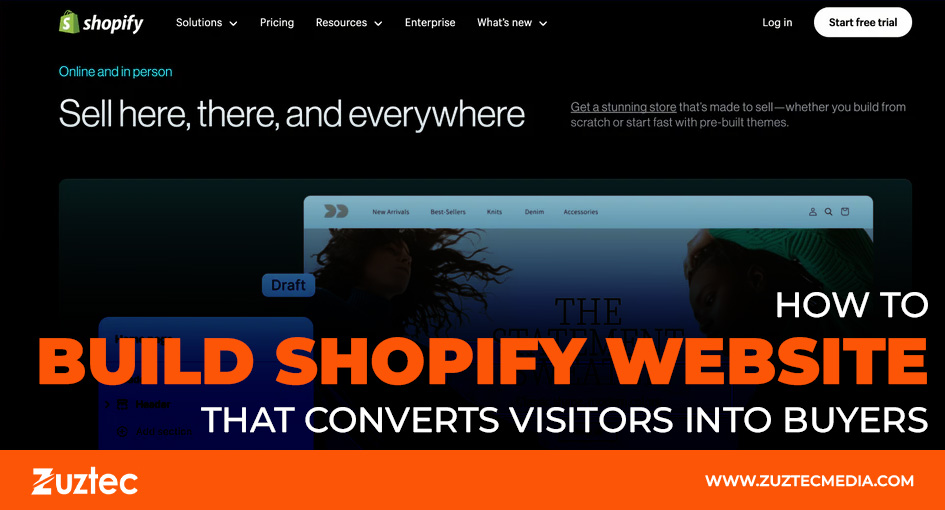
How to Build Shopify Website That Converts Visitors into Buyers
Creating a Shopify store is just the first step in launching an online business. Converting visitors into paying clients is the true difficulty. A high-converting Shopify website isn’t just about design; it requires strategic optimization to enhance user experience, build trust, and encourage purchases. To build Shopify website that converts visitors into buyers, one must focus on elements like fast-loading pages, mobile responsiveness, clear navigation, and persuasive product pages. Additionally, leveraging SEO, social proof, and AI-driven personalization can help increase conversions.
With rising competition in eCommerce, businesses must ensure their Shopify store provides a seamless shopping experience. If the website is difficult to navigate or lacks trust signals, visitors will leave without making a purchase. Optimizing every touchpoint from landing pages to checkout can significantly improve the store’s performance. To build a Shopify website that converts visitors into buyers, one must focus on elements like fast-loading pages, mobile responsiveness, clear navigation, and persuasive product pages. Additionally, leveraging SEO, social proof, and AI-driven personalization can help increase conversions. With effective strategies in place, one can ensure that visitors return and complete purchases, driving long-term success.
In this guide, we’ll cover essential steps to build a Shopify website that not only attracts traffic but also converts visitors into loyal customers. From selecting the right theme to optimizing checkout, these proven strategies will help to maximize sales in 2025.
Key Elements to Build Shopify Website That Converts
Consider the following points to build a Shopify website:
1. Choose a High-Performance Shopify Theme
A well-designed theme enhances the shopping experience and improves conversion rates. A high-performance Shopify theme should be:
- Sensitive to mobile devices to provide a seamless experience.
- Fast-loading to prevent high bounce rates.
- Visually appealing with a clean, professional layout.
Shopify offers free and premium themes, but investing in a premium theme provides better customization options, speed, and user experience.
2. Optimize Product Pages for Higher Conversions
Your product pages should be designed to convert visitors into buyers. Key optimization strategies include:
- Top-notch photos and movies that present products from various perspectives.
- Strong product descriptions that emphasize the advantages and features.
- Customer reviews and ratings to build trust.
- CTA buttons that are easy to see, such as “Buy Now” or “Add to Cart.”
To build Shopify website that converts visitors into buyers, a well-optimized product page reduces hesitation and increases conversions by making the purchasing process clear, persuasive, and easy.
3. Improve Website Navigation and User Experience
An intuitive shopping experience makes it easier for visitors to find what they need. Ensure your Shopify website has:
- A simple, structured menu for easy browsing.
- A search bar to facilitate speedy product discovery.
- Breadcrumb navigation to improve usability.
Streamlined navigation keeps visitors engaged and guides them toward making a purchase.
4. Leverage AI-Powered Personalization
AI-driven personalization enhances the shopping experience and boosts sales by:
- Recommending products based on customer behavior.
- Sending personalized email offers to potential buyers.
- Using chatbots for instant support.
Shopify integrates with AI-powered tools that help automate and customize the shopping journey.
5. Implement SEO Best Practices
SEO improves visibility and attracts organic traffic. To optimize your Shopify store:
- Use keyword-rich product titles and descriptions.
- Optimize images with alt tags and compressed file sizes.
- Start a blog with insightful material to increase traffic.
- Build backlinks to strengthen domain authority.
By making sure your store appears higher in search results, SEO raises the possibility of sales.
6. Optimize Checkout and Payment Options
A complicated checkout process leads to cart abandonment. Improve conversions by:
- Offering multiple payment methods like PayPal, Apple Pay, and credit cards.
- Providing a guest checkout option for faster purchases.
- Reducing checkout steps to make transactions seamless.
To build Shopify website that converts visitors into buyers, a smooth checkout process removes friction and encourages more purchases, resulting in higher conversion rates.
7. Build Trust with Social Proof and Security Badges
Consumers who trust a store are more inclined to make a purchase. Increase credibility by:
- Displaying trust badges such as “Secure Checkout” and “Money-Back Guarantee.”
- Featuring real customer reviews and testimonials.
- Highlighting social media proof like user-generated content.
Trust signals reassure visitors that your Shopify store is reliable and safe for transactions.
8. Use Retargeting and Email Marketing to Recover Lost Sales
On their initial visit, not every visitor will buy. Bring them back with:
- Retargeting ads that remind them of previously viewed products.
- Email marketing campaigns offering discounts and recommendations.
- Recovery emails for abandoned carts to increase lost sales.
These follow-up strategies help recover potential buyers and boost overall revenue.
9. Optimize for Mobile Shopping
With most shoppers using mobile devices, your Shopify website must be mobile-friendly. Ensure:
- Fast-loading pages for smooth browsing.
- An adaptable design that changes to fit various screen sizes.
- Easy-to-click buttons and CTAs for effortless navigation.
A mobile-optimized store prevents lost sales due to poor user experience.
How to Build Shopify Website That Converts Visitors into Buyers
To effectively build a Shopify website that converts visitors into buyers, you must focus on optimizing the entire shopping experience. Key areas include an engaging product page design, mobile-friendly features, seamless checkout, effective SEO strategies, and personalized shopping recommendations. Together, these components increase conversions and sales.
To sum up, to build Shopify website that converts visitors into buyers, businesses need a strategic approach that goes beyond basic store setup. A well-designed theme, optimized product pages, seamless navigation, and AI-driven personalization play a crucial role in improving conversions. Implementing SEO strategies, trust-building elements, and retargeting techniques can further enhance your store’s performance. With a mobile-friendly and fast-loading Shopify website, you can create a seamless shopping experience that encourages visitors to make a purchase. In today’s competitive eCommerce landscape, businesses must continuously refine their Shopify store to stay ahead. By focusing on these essential strategies, you can increase conversion rates, boost revenue, and build a loyal customer base in 2025. Start optimizing your Shopify website today and turn your visitors into long-term buyers!

